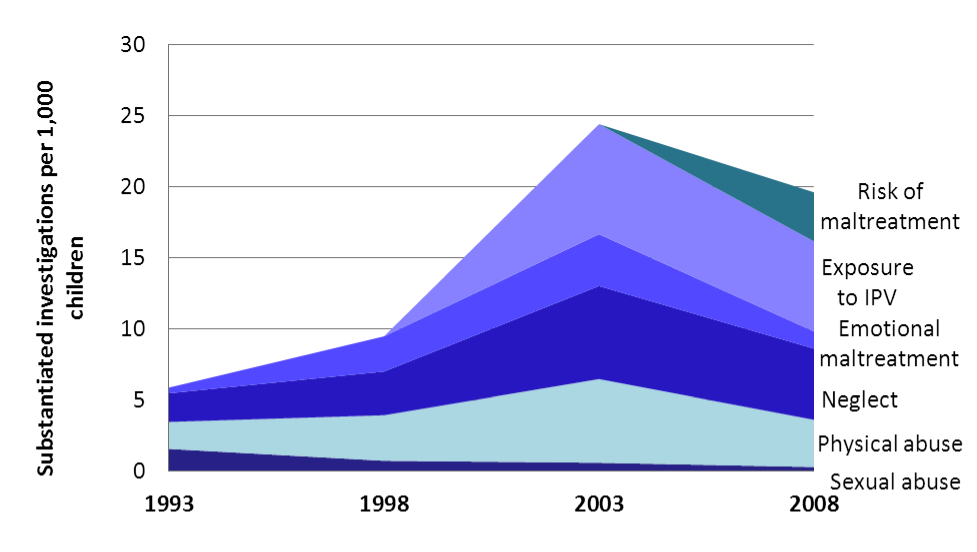Van Wert, M., Smith, C., Ma, J., & Fallon, B. (2012). Primary Category of Substantiated Child Maltreatment in Ontario in 1993, 1998, 2003, and 2008. Canadian Child Welfare Research Portal: Toronto, ON.
Introduction
The Ontario Incidence Study of Reported Child Abuse and Neglect (OIS), 2008 is the fourth provincial study to examine the incidence of reported child maltreatment and the characteristics of children and families investigated by child welfare authorities in Ontario. The first OIS was conducted in 1993, with subsequent studies in 1998, 2003, and most recently 2008. The OIS collects information about child maltreatment-related investigations directly from investigating child protection workers. This fact sheet compares maltreatment investigations documented in the 1993, 1998, 2003, and 2008 cycles of the OIS, specifically examining the primary form of maltreatment identified in substantiated investigations.
The OIS-2008 used a multi-stage sampling design to select a representative sample of 23 child welfare agencies in Ontario and then to select a sample of cases within these agencies. Information was collected from child protection workers on a representative sample of 7,471 child protection investigations conducted during a three-month sampling period in 2008. This sample was weighted to reflect provincial annual estimates.
Changes across time can be attributed to a number of factors, including (1) changes in public and professional awareness of maltreatment, (2) changes in legislation or case-management practices, (3) changes in the OIS study procedures and definitions, and (4) changes in the actual rate of maltreatment. Importantly, risk assessments were not explicitly tracked in the OIS prior to the 2008 cycle, creating difficulties in making comparisons over time.
Figure 1 displays the primary maltreatment type in substantiated investigations across the four cycles of the OIS. This figure displays cumulative incidence rates, meaning that the top of the bars represents the incidence per thousand children 15 years of age and under for all substantiated investigations in each cycle. In 2008, substantiated risk investigations are represented. Risk assessment investigations were deemed to be substantiated if the worker felt that the child was indeed at risk of future maltreatment. It is important to remember that exposure to intimate partner violence was not measured as a maltreatment category in 1993 or 1998, and risk assessments were not tracked until the 2008 cycle. Because of these changes in methodology, it is difficult to know how risk assessments were represented in cycles previous to 2008.
Figure 1: Primary category of substantiated child maltreatment investigations in Ontario over time

The overall incidence of substantiated investigations spiked in 2003. In 1993, there were an estimated 5.9 substantiated maltreatment-related investigations per 1,000 children age 0-15. This incidence increased in 1998, with an estimated 9.82 substantiated maltreatment-related investigations per 1,000 children age 0-15. There was a dramatic increase in substantiated investigations in 2003, with 24.44 investigations substantiated per 1,000 children, and a non-significant decrease in substantiated investigations in 2008, with 19.65 investigations substantiated per 1,000 children.
The rate of substantiated neglect doubled from 1998 (3.06 per 1,000) to 2003 (6.55 per 1,000). Substantiated sexual abuse appears to be declining over time, from a rate of 1.6 in 1993 to a rate of .32 in 2008. In both 2003 and 2008, the primary substantiated maltreatment category with the highest incidence rate was exposure to intimate partner violence.
Limitations of the OIS-2008
The OIS-2008 does not include information about unreported maltreatment, or cases that were only investigated by police. Reports that were made to child welfare authorities but screened out before they were investigated are not included, and reports on cases currently open at the time of case selection are also not included. The study does not track longer term service events that occur beyond the initial investigation.
